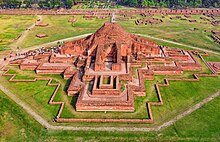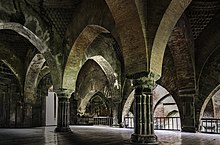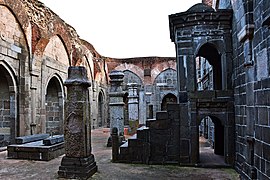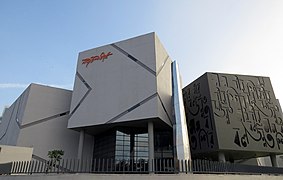Architecture of Bengal

The Architecture of Bengal, which comprises the modern country of
Bengal is not rich in good stone for building, and traditional Bengali architecture mostly uses brick and wood, often reflecting the styles of the wood, bamboo and thatch styles of local vernacular architecture for houses. Decorative carved or moulded plaques of terracotta (the same material as the brick) are a special feature. The brick is extremely durable and disused ancient buildings were often used as a convenient source of materials by local people, often being stripped to their foundations over the centuries.
Antiquity and Buddhism
This section needs additional citations for verification. (March 2021) |

Ancient Bengali architecture reached its pinnacle during the
Medieval and early modern periods
Hindu and Jain
Bengal was one of the

The term

Most temples surviving in reasonable condition date from about the 17th century onwards, after temple building revived; it had stopped after the Muslim conquest in the 13th century.[4] The roofing style of Bengali Hindu temple architecture is unique and closely related to the paddy roofed traditional building style of rural Bengal.[5] The "extensive improvisation within a local architectural idiom"[4] which the temples exhibit is often ascribed to a local shortage of expert Brahmin priests to provide the rather rigid guidance as to correct forms that governed temple architecture elsewhere. In the same way the terracotta reliefs often depict secular subjects in a very lively fashion.
Roofing styles include the jor-bangla, do-chala, char-chala, at-chala, and ek-ratna. The do-chala type has only two hanging roof tips on each side of a roof divided in the middle by a ridge-line; in the rare char-chala type, the two roof halves are fused into one unit and have a dome-like shape; the double-storey at-chala type has eight roof corners.[6][3]
Many of these temples are covered on the outer walls with
In larger, and later, temples, small towers rise up from the centre or corners of the curving roof. These are straight-sided, often with conical roofs. They have little resemblance to a typical north Indian
The temple structures contain gabled roofs which are colloquially called the chala, For example, a gabled roof with an eight sided pyramid structured roof will be called "ath chala" or literally the eight faces of the roof. And frequently there is more than one tower in the temple building. These are built of laterite and brick bringing them at the mercy of severe weather conditions of southern Bengal. Dakshineswar Kali Temple is a nine-spired temple [7] while the additional small temples of Shiva along the river bank are example of southern Bengal roof style though in much smaller dimension.
-
A deul Jain temple
-
A Pancharatna temple
-
Classification of Bengal Temple Architecture
Islamic

Bengal Sultanate

The Bengal Sultanate (1352–1576) normally used brick as the primary construction material, as pre-Islamic buildings had done.[10] Stone had to be imported to most of Bengal, whereas clay for bricks is plentiful. But stone was used for columns and prominent details, often re-used from Hindu or Buddhist temples.[11] The early 15th century Eklakhi Mausoleum at Pandua, Malda or Adina, is often taken to be the earliest surviving square single-domed Islamic building in Bengal, the standard form of smaller mosques and mausoleums. But there is a small mosque at Molla Simla, Hooghly district, that is probably from 1375, earlier than the mausoleum.[12] The Eklakhi Mausoleum is large and has several features that were to become common in the Bengal style, including a slightly curved cornice, large round decorative buttresses and decoration in carved terracotta brick.[13]
These features are also seen in the

Buildings in the style are the
Both capitals of the Bengal Sultanate, first Pandua or Adina, then from 1450 Gauda or Gaur, started to be abandoned soon after the conquest of the sultanate by the Mughals in 1576, leaving many grand buildings, mostly religious. The materials from secular buildings were recycled by builders in later periods.[10] While minarets are conspicuously absent in most mosques, the Firoz Minar was built in Gauda to commemorate Bengali military victories.
The ruined Adina Mosque (1374–75) is very large, which is unusual in Bengal, with a barrel vaulted central hall flanked by hypostyle areas. It is said to be the largest mosque in the sub-continent, and modeled after the Ayvan-e Kasra of Ctesiphon, Iraq, as well as the Umayyad Mosque of Damascus.[17] The heavy rainfall in Bengal necessitated large roofed spaces, and the nine-domed mosque, which allowed a large area to be covered, was more popular there than anywhere else.[18] After the Islamic consolidation of Bengal was complete, some local features continued, especially in smaller buildings, but the Mughals used their usual style in imperial commissions.[10]
-
A multi-domed Sultanate era mosque
-
A Bengali mihrab
-
TheDo-chala style roof.[19]
-
3D model of a reconstructed Bara Katra (Great Caravanserai of Dhaka) from the Mughal era
-
Mughal era domes in Murshidabad
-
A Sultanate era gateway
-
A Sultanate era standalone minaret
-
A Sultanate era arch
-
A Sultanate era stone mosque
-
An early Sultanate era mosque and tomb
-
The Sultanate era Adina Mosque
-
Interior of a Sultanate era imperial mosque
-
A Sultanate era mausoleum
-
A Sultanate era stone mosque
-
A Mughal era bridge in Sonargaon
-
South-East Gate of Lalbagh Fort in 1875
British Colonial period


The period of
Neoclassical

European influence on architecture.
-
Victoria Memorial is a famous example is Indo-sarasenic architecture.
-
Indian Museum, the oldest Museum in subcontinent, Neoclassicism.
-
Hazarduari Palace, Murshidabad, Palladian style
-
Metropolitan Building, Kolkata
-
Metcalfe Hall, Kolkata
-
Dhaka high court
-
Writers' Building, Kolkata, Victorian style
-
Telegraph Check Office, Kolkata, Italianate style.
-
Oberoi Grand Hotel, Kolkata
-
Town Hall, Kolkata, Doric style
Indo-Saracenic architecture can be seen in the Ahsan Manzil and Curzon Hall in Dhaka, Chittagong Court Building in Chittagong, and Hazarduari Palace in Murshidabad. The Victoria Memorial in Kolkata, designed by Vincent Esch also has Indo-Saracenic features, possibly inspired from the Taj Mahal.
Bungalows

The origin of the bungalow has its roots in the vernacular architecture of Bengal.[21] The term baṅgalo, meaning "Bengali" and used elliptically for a "house in the Bengal style".[22] Such houses were traditionally small, only one storey and detached, and had a wide veranda were adapted by the British, who used them as houses for colonial administrators in summer retreats in the Himalayas and in compounds outside Indian cities.[23] The Bungalow style houses are still very popular in the rural Bengal. In the rural areas of Bangladesh, it is often called “Bangla Ghar” (Bengali Style House). The main construction material used in modern time is corrugated steel sheets. Previously they had been constructed from wood, bamboo and a kind of straw called “Khar”. Khar was used in the roof of the Bungalow house and kept the house cold during hot summer days. Another roofing material for Bungalow houses has been red clay tiles.
Art Deco
Art deco, which originated after the first World war, became prevalent all over India. Art deco is seen in the bungalows of Kolkata as well, which are being destroyed and replaced by high-rise buildings.[20][24][25] Art Deco influences continued in Chittagong during the 1950s.
Modernism
| Part of a series on |
| Bengalis |
|---|
 |
*
-
Anart deco building in Chittagong
-
Bangladeshi rooftop garden
-
A Rubik's cube style building in Dhaka
In 2015, Marina Tabassum and Kashef Mahboob Chowdhury were declared winners of the Aga Khan Award for Architecture for their mosque and community center designs respectively, which were inspired by the region's ancient heritage.[26]
See also
Notes
- ISBN 978-0-8386-3602-2.
- ^ "ASI, Kolkata Circle".
- ^ a b c d Amit Guha, Classification of Terracotta Temples
- ^ a b Michell, 156
- ^ 3.http://www.kamat.com/kalranga/wb/wbtemps.htm
- ^ "Architecture". Banglapedia. Retrieved 6 September 2009.
- ^ "Dakshineswar".
- ISBN 978-1-84511-381-0.
- ISBN 978-1-134-61365-6.
- ^ a b c Banglapedia
- ^ Hasan, 34-35
- ^ Hasan, 36-39
- ^ Hasan, 36-37; Harle, 428
- ^ Hasan, 23-25
- ^ Hasan, 41-44
- ^ Hasan, 44-49
- ^ "BENGAL – Encyclopaedia Iranica". www.iranicaonline.org. Retrieved 2019-07-15.
- ^ Hasan, 35-36, 39
- ISBN 9789231038761.
- ^ ISSN 0261-3077. Retrieved 2019-06-23.
- ^ bungalow > common native dwelling in the Indian province of Bengal
- ^ Oxford English Dictionary, "bungalow"; Online Etymology Dictionary
- ^ Bartleby.com
- ISSN 0971-751X. Retrieved 2019-06-23.
- ^ Guha, Divya (2015-08-25). "The fight to save Kolkata's heritage homes". BBC. Retrieved 2019-06-23.
- ^ "2 Bangladeshi projects among Aga Khan Award for Architecture winners". 3 October 2016.
References
- Harle, J.C., The Art and Architecture of the Indian Subcontinent, 2nd edn. 1994, Yale University Press Pelican History of Art, ISBN 0300062176
- Hasan, Perween, Sultans and Mosques: The Early Muslim Architecture of Bangladesh, 2007, I.B.Tauris, ISBN 1845113810, 9781845113810, google books
- Michell, George, (1977) The Hindu Temple: An Introduction to its Meaning and Forms, 1977, University of Chicago Press, ISBN 978-0-226-53230-1
Further reading
- Michell, George (Ed.), Brick Temples of Bengal - From the Archives of David McCutchion, Princeton University press, New Jersey, 1983
- Becker-Ritterspach, Raimund O.A., Ratna style Temples with an Ambulatory - Selected temple concepts in Bengal and the Kathmandu Valley, Himal Books, Kathmandu, 2016, ISBN 978 9937 597 29 6






![The Naulakha Pavilion at the Lahore Fort in Pakistan displays the distinct Bengali Do-chala style roof.[19]](http://upload.wikimedia.org/wikipedia/commons/thumb/7/7a/Naulakha_Pavilion_in_Lahore_Fort.jpg/321px-Naulakha_Pavilion_in_Lahore_Fort.jpg)































